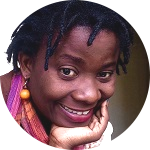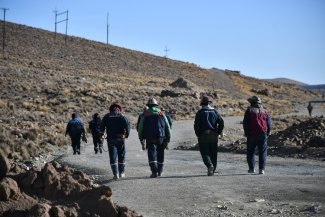
With almost half of its population under the age of 14, education is an issue of major concern in the DRC. But limited resources have led to several problems, including overcrowded classrooms and unpaid teachers.
On 20 August 2019, Tina Salama, spokesperson for then-newly elected president of the Democratic Republic of the Congo (DRC) Félix Tshisekedi, announced tuition-free schooling for all Congolese youth. Promoted as the beginning of a new era of education in the country, the aim was to ensure that children, especially those from low-income families and communities, have access to basic education. Both the Congolese population as well as international organisations providing assistance to the DRC welcomed the news. For a country with 36 million inhabitants under the age of 14 (46 per cent of the country’s population), four million children who didn’t attend school in 2018 according to the World Bank, and which ranks 175th (out of 189 countries) in the Human Development Index, the project was urgent.
Two years later, however, the country’s policy of tuition-free schooling has become the subject of fierce debate. Since the start of the 2020 school year, several schools have made the news. In some, teachers went on strike to demand payment of their salaries. In others, parents’ organisations decided to pay ‘motivational fees’ to teachers.
“On the whole, free schooling is not working well. Teachers are not being paid, the quality of education is not satisfactory […]. Today, we can legitimately ask if this free schooling policy has a future,” as Innocent Shamavu Bahala, regional president of the Force Syndicale Nationale du Nord-Kivu (FOSYNAT), tells Equal Times.
To understand why anyone would wish a return to the old system, it is necessary to look at the organisation of schooling in the DRC over the last few decades. Faced with a chronic lack of state resources, education was largely paid for by parents who supplemented teachers’ salaries. Their contributions came on top of a basic monthly salary of US$90 paid by the state. Depending on a family’s means, total remuneration could thus be higher, sometimes exceeding US$150, and occasionally rising to US$300 or US$400 at some schools in city centres.
Families spent an average of US$65 (€54) per year per child in primary school, according to UNICEF, a substantial sum in a country where GDP per capita is US$1,147 (€957). In cities, the number was often much higher. “I was paying almost US$300 every year for my three children,” says Jeanine Sikwangabere, a mother from Goma.
“The money was used to pay the teachers and run the school. The teachers were paid directly by the school and were more or less guaranteed their salary. In the new system, we only pay some fees to the schools. We know they shouldn’t be charging them but we pay them anyways, for the sake of our children’s education. And it ends up being less than what we paid before. That may be good news for our pocketbooks but not for the teachers, because no one else is paying their salaries.”
Unpaid teachers and suspicions of embezzlement
The educational community was in for a rude awakening at the start of the 2019-2020 school year. With pay now set at an average of US$207 by SECOPE (Service du Contrôle de la Paie des Enseignants), most teachers were hoping for a substantial improvement in their condition. Instead, with schools no longer able to charge families extra fees, some teachers saw a decrease in their real income, while some were not paid at all.
The distress of some was such that in Goma, paid teachers began contributing a portion of their salaries to help their forgotten colleagues. The Ministry of Primary, Secondary and Technical Education (EPST) denied any negligence, claiming that the situation was due to the presence of ‘new units’, teachers not yet officially recognised in the school system. “Until now, the presence of these unrecognised teachers did not pose a problem for the ministry, since we were the ones in charge of paying them,” says a head teacher who wished to remain anonymous due to the sensitive nature of the subject. Now that the ministry is responsible for these payments, the ‘new units’ have become a cause for concern.
With unrecognised teachers not being paid, strikes began to break out in many of the country’s schools after the start of the 2020 school year.
“No one is against the idea of free education. Parents want it for their children and teachers want to provide it. But the work of teachers must be recognised and remunerated,” says Shamavu Bahala.
The strikes ended once the state promised to pay salaries. In January 2021, 132,000 teachers were paid, according to the ministry, which also points to the fact that teachers who used to receive US$40-US$50 are now paid around US$150. “But the teachers we knew through the union weren’t among those paid!” says Shamavu Bahala. This was enough to raise suspicions that the money had been ‘gobbled up’ along the way, a reference to the common practice of money being deducted as it passes through each level of administration in order to cover costs for services.
FOSYNAT responded by asking the government to organise a fact-finding mission to explain the problems with paying salaries and to identify ‘new units’ in order that they be paid. The rapid investigation carried out found that a system of fictitious teachers had been set up to divert some of the funds. The Inspector General of the EPST, Michel Diamba Kaombo, was arrested and sentenced to 20 years’ hard labour.
Inadequate infrastructure and serious budgetary problems
While progress has been made in paying salaries, parents remain angry about another problem that resulted from the introduction of free education: overcrowded schools. “Classrooms have become the new lecture halls,” reports Fred Bauma in an analysis by the Congo Research Group, a reference to the overcrowded lecture halls of Congolese universities. Many schools have seen their enrolment explode since the introduction of free education.
“Free tuition was put into place before the accompanying measures were studied,” says Julienne Kasilamo, head of education at the Société Civile (a national network comprising several Congolese associations). “The necessary infrastructure isn’t there.
The government hasn’t built schools, hasn’t ordered desks. We saw schools where children were studying on the floor. According to UNESCO standards, a teacher cannot teach more than 50 students at the same time. Today we are at double that number, and even more in some schools.”
Similar problems are being reported all over the country and parents fear a decrease in the quality of education. “Of course, free education provides a ray of hope for many families who were previously unable to send their children to school due to a lack of funds. This is a good thing for the education of our children and we need it to rebuild our country. But the number of teachers must follow. We also need the means to acquire materials and infrastructure,” insists Kasilamo.
Is free primary and secondary school education tenable when teachers aren’t being paid and infrastructure is lacking? The government’s answers have hardly been reassuring. According to the Congo Research Group’s analysis, the cost of free education amounts to US$2.9 billion, or 42 per cent of the government’s budget.
Even more worrying is the fact that only US$440,000 have been allocated for the current school year, which represents only one sixth of the necessary budget. This situation has prompted the Observatory of Public Expenditure (ODEP), a Congolese organisation that specialises in monitoring state expenditures, to predict the failure of the president’s key promise and to describe it as ‘untenable’.
Faced with this situation, the government has announced its desire to resort to “innovative modes of financing”. But the innovation it envisions, which entails turning to external donors, in this case the World Bank, isn’t particularly innovative for the DRC. This approach doesn’t reassure Bauma of the Congo Research Group: “This is not a good situation. This aid is conditioned on reforms or promises of reforms which, if not implemented, could lead to its suspension.” This would risk leaving children without an education.
Examples from other countries
The DRC is not the only country in sub-Saharan Africa experiencing challenges in financing education. In 2017, Ghana’s then newly elected president Nana Akufo-Addo began implementing his campaign promise to make secondary education free.
The measure was a popular success, with enrolment increasing from 308,000 to 430,000 in one year. This of course posed a number of problems for schools, which had no time to prepare. The secondary education system has adapted by implementing a system of alternating attendance. Many parents are now furious that their children have nothing to do for two months and complain that they have no guarantee of a quality education. The president has pledged to build new schools and put an end the system by 2025.
This situation highlights the fundamental challenge that many low- and middle-income countries face in attempting to finance an education system that meets the expectations of their population.
According to UNESCO, in 2015 sub-Saharan African countries were already spending an average of 17 per cent of their budget on education (compared to 12 per cent in European and North American countries).
With the cost of primary and secondary education amounting to 49 per cent of the DRC’s budget, no one expects that the authorities are capable of doing more.
The only remaining option is external funding. But according to Bauma of the Congo Research Group, such solutions are not sustainable: “Ultimately, financing free education is an issue that cannot be separated from the state’s ability to mobilise revenue and end corruption. Without this, any external aid would simply be a quick fix that would leave us in a state of dependency.”









